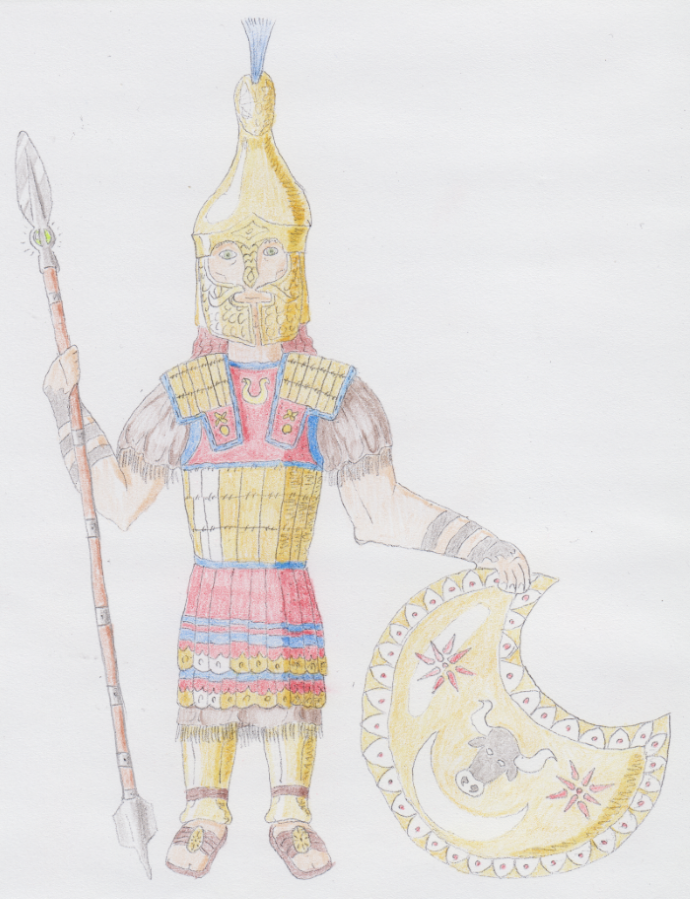Góalanics
The góalanics are native to Góalanis, but their population has since spread throughout eastern and parts of central Adynía since their kingdoms were conquered by orcish tribes from Úrún.
These kingdoms were a major rival of the Paþarían Empire, and waged many (usually inconclusive) wars against them and paþarían colonies in Góalanis over control of Goldensands and its rich source of magic crystals.
When the empire fell, the góalanics fell prey to orcish invaders from across the sea on an unprecedented scale, resulting in two centuries of war where the kingdoms fell one by one until Hirelos Svaras II, king of Eralía was defeated during the Battle of Nernis, after which the orcish tribes were in complete control over Góalanis and have been ever since.
Most góalanics in Góalanis are now little more than peasants, while those who've since settled in eastern Gysikan and the Sikíron Empire in central Adynía are renowned for their knowledge of magic, metallurgy and carpentry.
Góalanic magic staves and enchanted equipment are highly sought after, and are considered some the best in the world.
Many góalanics believe that the god Fanasis introduced these funerary practices in exchange for not harming his sacred aurochs.Knara; a general who fought during the orcish conquests.
Rados; leader of the last major góalanic revolt since the orcish conquests.
History
Historically, the góalanics were a major civilization in eastern Adynía. After adopting metallurgy from the Faronians, the technology spread to the cultures of central Adynía, ending Zameltonía's monopoly on bronze tools and weapons in the region. After the end of bronze age, the góalanics had established several kingdoms which frequently fought each other as well as their neighbors in Gysikan, Úrún and Ytis, establishing small colonies and trading posts along the shores of the latter two regions across Central Sea.These kingdoms were a major rival of the Paþarían Empire, and waged many (usually inconclusive) wars against them and paþarían colonies in Góalanis over control of Goldensands and its rich source of magic crystals.
When the empire fell, the góalanics fell prey to orcish invaders from across the sea on an unprecedented scale, resulting in two centuries of war where the kingdoms fell one by one until Hirelos Svaras II, king of Eralía was defeated during the Battle of Nernis, after which the orcish tribes were in complete control over Góalanis and have been ever since.
Most góalanics in Góalanis are now little more than peasants, while those who've since settled in eastern Gysikan and the Sikíron Empire in central Adynía are renowned for their knowledge of magic, metallurgy and carpentry.
Language
Góalanics traditionally use their own alphabet, characterized by rune-like letters where each stands for a specific sound, as well as a particular kind of tree or shrub.Magic studies
Historically, every góalanic warrior would be trained in combat using both mundane and arcane means, using the latter in case their weapons failed. This also meant that many góalanics, even those of low stature knew simple spells to aid them in daily life, such as for lighting fire under difficult conditions, healing minor wounds and using light magic to see without torches.Góalanic magic staves and enchanted equipment are highly sought after, and are considered some the best in the world.
Religion
As with most Adyníans, góalanics practice a form polytheism made of a pantheon of a few major gods and myriad minor ones, the latter usually only being worshipped as a part of local cults.Notable deities
Asirkil
Goddess of war and magic, known as Asirkelía among góalanics in the Sikíron Empire. She's usually depicted as pale, with black hair and sometimes weeping, due to the belief that magic crystals are formed from her tears. Asirkil has a sanctuary in the city of Hökía in Góalanis, where she's shown clad in armour, shield and magic staff in hand, with a hunting dog by her feet.Fanasis
One of the most important god in góalanic mythology, usually shown as a bull with a broken horn or a minotaur holding a cornucopia. Originally a protector of kings, his role as a fertility god has since replaced it for the most part. Fanasis is also associated with the afterlife.Koní
A divine phoenix who rises from flames each dawn and then bursts into flames at dusk, believed to be the cause of the sky reddening during twilight.Tarnil
Goddess of the sea and the moon, wife of Fanasis.Funerary rites
In ancient times, when a góalanic died they were placed in an old boat, along with a drinking horn, and placed in a burrow. Nowadays góalanics bury their dead with a small boat replica along with the horn and other grave goods, though usually not food. The reason for this is that the horn is believed to transform into a cornucopia once the soul reaches the shores of the land of the dead.Many góalanics believe that the god Fanasis introduced these funerary practices in exchange for not harming his sacred aurochs.
Notable góalanics
Diverged ethnicities
Encompassed species
Related Organizations




Comments